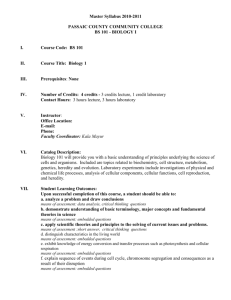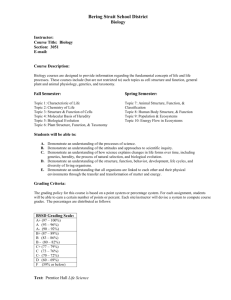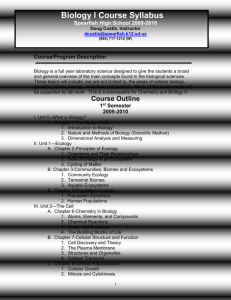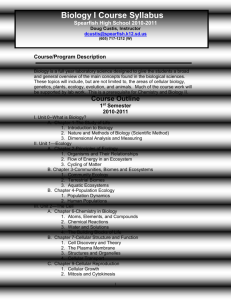AP Biology Syllabus - Atlanta Public Schools
advertisement
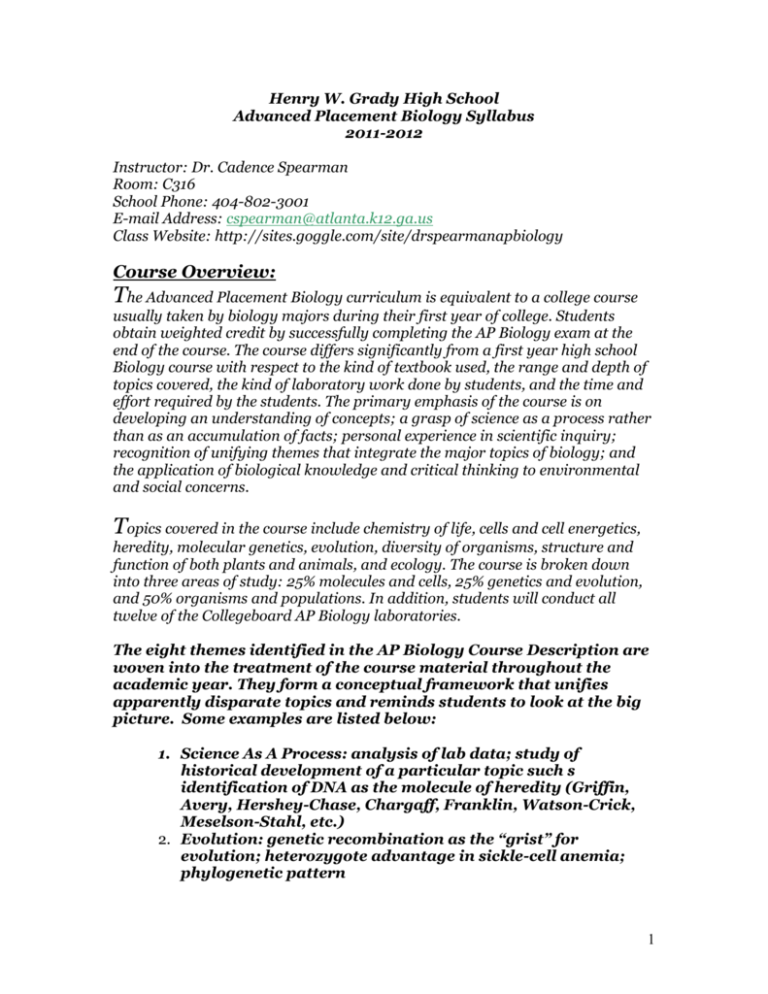
Henry W. Grady High School Advanced Placement Biology Syllabus 2011-2012 Instructor: Dr. Cadence Spearman Room: C316 School Phone: 404-802-3001 E-mail Address: cspearman@atlanta.k12.ga.us Class Website: http://sites.goggle.com/site/drspearmanapbiology Course Overview: The Advanced Placement Biology curriculum is equivalent to a college course usually taken by biology majors during their first year of college. Students obtain weighted credit by successfully completing the AP Biology exam at the end of the course. The course differs significantly from a first year high school Biology course with respect to the kind of textbook used, the range and depth of topics covered, the kind of laboratory work done by students, and the time and effort required by the students. The primary emphasis of the course is on developing an understanding of concepts; a grasp of science as a process rather than as an accumulation of facts; personal experience in scientific inquiry; recognition of unifying themes that integrate the major topics of biology; and the application of biological knowledge and critical thinking to environmental and social concerns. Topics covered in the course include chemistry of life, cells and cell energetics, heredity, molecular genetics, evolution, diversity of organisms, structure and function of both plants and animals, and ecology. The course is broken down into three areas of study: 25% molecules and cells, 25% genetics and evolution, and 50% organisms and populations. In addition, students will conduct all twelve of the Collegeboard AP Biology laboratories. The eight themes identified in the AP Biology Course Description are woven into the treatment of the course material throughout the academic year. They form a conceptual framework that unifies apparently disparate topics and reminds students to look at the big picture. Some examples are listed below: 1. Science As A Process: analysis of lab data; study of historical development of a particular topic such s identification of DNA as the molecule of heredity (Griffin, Avery, Hershey-Chase, Chargaff, Franklin, Watson-Crick, Meselson-Stahl, etc.) 2. Evolution: genetic recombination as the “grist” for evolution; heterozygote advantage in sickle-cell anemia; phylogenetic pattern 1 3. Energy Transfer: conservation of energy; respiration and photosynthesis; ATP as an energy storage molecule to drive cell processes; food and energy pyramids 4. Continuity an Change: Mendelin genetics, DNA replication, mutation, selective advantage, behavioral reproductive barriers 5. Relationship of Structure to Function: enzyme specificity, cell type diversity, organ structure and function(ex: inner ear) 6. Regulation: Positive and negative feedback loops in metabolic pathways; feedback loops in human endocrine pathways (ex. thyroid goiter, competition in regulating population 7. Interdependence in Nature: coevolution, mutualism (ex. mycorrhizzae, lichen) predator-prey cycles, food webs decomposers, nitrogen fixation 8. Science, Technology, and Society: lab activities such as DNA electrophoresis and gene transfer, class discussions on ethical issues (ex. cloning, designer” babies, environmental impact of industrial society A poster listing the eight themes is displayed in the classroom. At appropriate opportunities during class discussions students will be challenged to identify connections of the topic at hand to one or more of the themes. Goals: 1. To familiarize students with the terminology and concepts of Biology using a theme-oriented approach that emphasizes concepts and science as a process over knowledge of facts. 2. To enhance problem-solving skills of students using hands-on labs, readings, collections, independent projects, and class discussions. 3. To strengthen students’ communication skills with the use of written assignments, essays, abstracts, and lab reports. 4. To prepare students for further study in the Biological Sciences. 2 Timeline First Semester Subject Weeks of Instruction % of AP Test Chemistry of Life 2.5 7% Cells 6.5 18% Genes 6.5 17% Second Semester Mechanics of evolution 2 8% Biological Diversity 2.5 8% Plant Form & Function 3.5 12% Animal Form & Function 7.0 20% Ecology 2.0 10% Textbook & Study Resources (New Textbooks will be given out once they arrive): Biology 8th ed. By Campbell, Reece, & Mitchell, Benjamin/Cummings Publishing, 2008. CD-ROM: Interactive Study Partner, By Campbell, Reece, & Mitchell, Benjamin/Cummings Publishing, 2008. Student Study Guide for Campbell's Biology, 8th Edition. 2008. Benjamin/Cummings Publishing Co., Inc. Laboratory Manual: Advanced Placement Biology Laboratory Manual for Students, College Entrance Examination Board, 2002. 3 Required Materials: 3-ring binder with pocketed dividers Standard size, loose leaf notebook paper Quadrille Composition notebook Pencils with erasers Colored pencils Folder with 2 pockets for Lab Reports Graph paper Black ink pens Typing paper Access to the internet & a word processor Graphing calculator Good collegiate level dictionary Grading Scale: Exams (unit tests, major projects, etc.) Lab Reports, lab tests, & lab practicals Daily work, abstracts, etc. 45% 40% 15% 90-100% -A 69 and below- F 80-89%-B 70-79%- C Labs: Students are required to complete twelve (12) labs set forth by The College Board Advanced Placement Program. Students are expected to read each lab carefully before coming to the laboratory and are responsible for following all correct laboratory and safety procedures. Students should also use the lab aid, LabBench, to make sure they understand all lab procedures before beginning a lab exercise. Due to the large amount of time required for laboratory set-up, it is essential that you are always present on lab days. Please be prepared to stay after school to finish long labs that you are unable to complete in the allotted lab time. Additional labs will be included such as bioremediation of oil and industrial pollutants, gram staining techniques, and dissection of the fetal pig. Within one week of completing the lab, students will turn in professional quality, typed lab reports in the format provided by the instructor. Lab reports will be weighted and count 30% of each nine weeks grade. Projects: 1. During 1st semester, students will complete and submit an individual science fair project. Selected students and projects will then proceed to the district fair in February 2012 and possibly to the International Fair in .April/May 2012. 4 2. During the second semester, students will contact a research scientist or field biologist in our area and conduct an interview about their current research. Using their interview notes, they will write a newspaper article (Who, what, when, where, and Why) about this scientist and their research. This article is due during the third nine weeks. 3. Students will read and abstract a current article from a scientific journal. Articles must be chosen from journals published during the 6 months prior to the abstract due date. The abstract and a copy of the article or journal must be turned into the instructor in an abstract folder and must follow the format provided by the instructor. Mid-Semester Grade: The mid-semester grade will provide information about a student’s performance during the first half of the semester. However, the report card and grade issued as this time is merely a progress report. It is not a final grade and does not appear on the permanent record transcripts. Progress Reports and Deficiency Notices: issued periodically so as to monitor the student’s performance. A deficiency notice will be issued when a student’s grade drops below 80%. It will state the areas that appear to contribute to the unsatisfactory grade. These notices will be sent home at least twice a semester according to the APS calendar in September, November, February, and April. They will also be sent home as needed. Parents, please make sure that I have your correct mailing and email address. Progress Reports/ Deficiency Notices Schedule 9/7/2011 11/11/2011 2/3/2012 4/13/2012 Report Card Schedule 10/14/2011 1/10/2012 3/6/2012 6/1/2012 Parent-teacher conferences: Conferences need to be scheduled through the counseling department. However, questions and concerns can be delivered via email or by calling the school and leaving a message, if desired. Tutorials: Students may stay after school and receive additional help or make up missed work for excused absences, Monday (3:20-4:20pm) or by appointment. Class Policies and Procedures: 1. Daily attendance is expected. It is difficult to keep up and be successful in class when there are numerous absences. It is especially hard to make up missed lab work. Therefore, IF YOU MISS A SCHEDULED TEST/LAB YOU WILL BE REQUIRED TO TAKE AN ESSAY FORM OF THE EXAM AND A SUBMIT A 3-5 PAGE RESEARCH PAPER ABOUT 5 THE CONCEPTS COVERED IN LAB AS WELL AS A FORMAL LAB REPORT. A NOTE FROM A PARENT/GUARDIAN REGARDING AN EXCUSED ABSENCE IS REQUIRED FOR ACCEPTANCE OF LATE WORK WITHOUT PENALTY( THIS DOES NOT INCLUDE PROJECTS OR ANY OTHER MAJOR ASSIGNMENT ASSIGNED IN ADVANCE). Tests and missed work must be made up within three class days after returning from an excused absence. A student that has been marked truant (cut/skipped) will not be allowed to make up missing work. A suspended student must follow the school guidelines to ensure that they get the missed assignments. 2. Come to class prepared daily with textbook, supplies and assignments. 3. Students may make corrections to any test, excluding the mid-term and final exams, and receive additional credit. Students must attend at least one thirty (30) minute tutorial session before attempting the test corrections. These corrections must be completed in after school tutorial after the mandated tutorial session within two weeks after the test has been returned. 4. “Due Date” versus “Do Date”. If a student does not have his or her assignments completed on the date that it is due, they have until the test date for that unit to turn in the assignments for a grade of 50. After that day, the assignments will not be accepted. See the policies for missed work due to excused absences. 5. Laboratory safety is of vital importance. To encourage students to practice safe lab procedures and follow safety rules, points will be deducted for not following the rules of the lab. 6. The AP Biology Exam is required and will be taken in May 14 , 2012, 8am (please report by 7:45am). 7. Respectable behavior is expected at all times. 8. Cheating will not be tolerated. Cheating can be as obvious as intentionally looking at someone’s test or as simple as copying an answer from a friend’s homework assignment. Regardless, cheating or plagiarizing will result in a grade of a “0”. If you are uncertain about what constitutes cheating or plagiarizing, please ask questions before you receive a zero. 9. Food and drinks are not allowed in class (water bottles are acceptable.) 6 10. Lost or damaged property is to be paid for by the student or parent/guardian. Students will be responsible for the replacement costs of any broken laboratory equipment (i.e., glassware, balances, etc.). 11. All cellular telephones, other communication and electronic devices are to be turned off and not visible during school hours. Please see the attached APS policy on electronic devices. 12. Students will not be allowed to leave the classroom to go to their lockers. AP Exam Preparation: May 14, 2012, 8am All students are required to take the Advanced Placement test given in May; therefore, throughout the course students will use past AP Biology essay questions to improve their skills in writing answers to scientific, free-response questions. Also, all major exams will follow the AP testing format of 60% multiple choice and 40% essay questions. It is strongly recommended that students purchase an AP Biology test prep book. There are many, many varieties and they all can be found at a local bookstore. Take the practice tests in these books so that you can become familiar with what to expect. When trying to find an AP Biology test prep book, choose one that also lets you see sample essays. Some books just focus on the multiple choice, and you need to be exposed to both parts of the exam. Outline of the AP Biology Exam: 100 multiple choice in 80 minutes = 60% of test Four (4) Free Response Essay Questions in 90 minutes (10 minutes reading time) = 40% of test Essay Section Hints: 1. 2. 3. 4. 5. 6. The 4 essay questions are graded equally. One question is on molecules and cells. One question is on genetics and evolution. Two questions are on organisms and populations. One or more of the questions will be lab-based. Write in essay form! There is room on the test for you to create an outline to guide your answer if you'd like but outlines are not graded. That being said, perfect essay writing is not expected. There aren't deductions for grammar or spelling mishaps (provided the spelling is close enough to determine the word you are trying to write). 7. Diagrams are helpful! If you use a diagram, be sure to refer to it in your essay. 7 8. Points are not deducted from your essay score if you give an incorrect statement. (You just don't receive points for incorrect statements). But be careful not to contradict yourself, because this can cause you to not receive points. Learner Objectives: Chemistry of Life To understand the unique chemical and physical properties of water and to know how these properties make life on earth possible To explain the role of carbon in the molecular diversity of life To explain how cells synthesize and break down macromolecules To explain the structure of biologically important molecules To explain how enzymes regulate chemical reactions Cells To explain the similarities, differences and evolutionary relationships between prokaryotic and eukaryotic cells To understand the current model of membrane structure and to explain how different molecules pass across the membrane To show how cells use compartmentalization to organize the various cellular function To understand which factors limit cell size and to explain how and why cells divide Cellular Energetics To demonstrate the role of ATP and the chemiosmotic theory in cellular energetics To show how organic molecules are catalyzed To explain the photosynthetic process and to show how it compares and contrasts with cellular respiration Heredity To explain which features of meiosis are most important to sexual reproduction To follow the paths of chromosomes and individual genes through gametogenesis To explain how genetic information is organized To demonstrate and understanding of the importance of Mendel’s Laws of inheritance 8 Molecular Genetics To know the major types of nucleic acids and explain how their structure is related to their function To understand the various mechanisms of gene expression To show the forms of gene mutation To explain viral structure and replication To understand modern biotechnological advances and how they may impact human lives Evolutionary Biology To show and understanding of the current models for the origin of biological macromolecules To explain the evidence of evolution To demonstrate an understanding of the mechanics of evolution at work Diversity of Organisms To explain the main body plans of plants and animals To identify a representative organism for the major taxa To explain the major characteristics in each primary taxon To show evolutionary similarities among related groups Structure and Function of Plants and Animals To show what patterns of reproduction are found in plants and animals and to show how they are regulated To understand physiological organization among living things To explain how organisms respond to their environment Ecology To show how models can be used to demonstrate population growth To show how energy flows through ecosystems To explain how humans may impact the ecosystem around them 9 Scope & Sequence: Based on alternating A/B classes that meet for 88 minutes First Nine Weeks - Molecules and Cells Date Topic of Study Chapters to read Chapter 1 10 days Chemistry & Biochemistry Chapter 2 Chapter 3 Chapter 4 Chapter 5 Labs/Projects Tutorial Links Lab 2: Enzyme Catalysis Periodic Table Students will observe enzymatic reactions; demonstrate the effect of boiling on enzymatic activity; demonstrate the presence of catalase in living tissue; determine the amount of H2O2 initially present in a 1.5% solution Chemistry Review Macromolecule Problems Acids & Bases pH Problems Organic Models Unit one Test - Biochemistry Lab 1: Osmosis & Diffusion Cell Size Cells Alive! 7 days Cells Chapter 6 Chapter 7 Chapter 11 Chapter 12 Chapter 13 Students will measure diffusion of small molecules through dialysis tubing, an example of a semi permeable membrane. Students will use dialysis tubing to investigate the relationship between solute concentration and the movement of water through a semi permeable membrane by the process of osmosis Cell Cycle & Mitosis Meiosis Onion Root Tips Microscopy Lab 10 Unit 2 Test over Cells (chapters 7,8,11,12,13) 6 days Chapter 8 Cellular Energetics Chapter 9 Chapter 10 Lab 5: Cell Respiration Photosynthesis Problem Set 1 Students will measure oxygen consumption during Photosynthesis Problem Set 2 germination; measure the change in gas volume in Metabolism Problem Sets respirometers containing either germinating or nongerminating pea seeds; and measure the rate of respiration of these peas at two different temperatures. Lab 4: Plant Pigments & Photosynthesis Students will separate plant pigments using chromatography and measure the rate of photosynthesis in isolated chloroplasts. Unit 3 Test over Cellular Energetics (chapters 6, 9, & 10) Second Nine Weeks - Genetics The Cell Cycle & Mitosis Tutorial Lab 3: Mitosis & Meiosis 7 days Chapter 14 Heredity Chapter 15 Students will observe mitosis in plant and animal cells onion root tip and whitefish blastula. Students will determine how much time a cell spends in each phase of cell replication from a slide of dead cells. Online Onion Root Tip Activity Cell Division Laboratory Tutorial Problem sets Genetics Problem sets Human Biology Genetics On-line Activity Web Karyotyping Unit 4 Test over Heredity (chapters 14 & 15) 11 Lab 6: Molecular Biology Chapter 16 chapter 17 10 days Molecular Genetics Chapter 18 Chapter 19 Chapter 20 Chapter 21 Students will insert a plasmid that contains a gene for the resistance to ampicillin , an antibiotic that is lethal to many bacteria, into competent E.coli cells. DNA fragments will be separated by using gel electrophoresis Bioremediation of Spilled Oil & Industrial Pollutants J. Watson bio DNA diagrams Nucleic Acids Practice Test Molecular Biology Bacterial Genetics and Recombinant DNA Unit 5 Test over Molecular Genetics (chapters 16 - 21) Third Nine Weeks - Evolution, Taxonomy, Plants Chapter 22 7 days Chapter 23 Evolutionary Biology Chapter 24 Chapter 25 Lab 7: Genetics of Drosophila Students will make The Museum of Paleontology observations and keep (UCMP) records concerning what happens as mutant traits are Galapagos Website passed from generation to the next. Unit 6 Test over Evolution (chapters 22-25) Chapter 26 6 days Diversity of Organisms Chapter 27 Chapter 28 Chapter 31 Lab 8: Population Genetics & Evolution Students will estimate the allele frequency of a gene controlling the ability to taste the chemical PTC; estimate the allele frequencies of an ideal Hardy-Weinberg community; and modify the simulation to imitate Introduction to Viruses Introduction to Protists Protist Image Data Introduction to the Fungi 12 selection against a trait Gram Staining Lab Unit 7 Test over Taxonomy, Prokaryotes, & Simple Eukaryotes (chapters 26, 27,28, and 31) 11 days Structure & Function of Plants Chapter 29 Chapter 30 Chapter 35 Chapter 36 Chapter 37 Chapter 38 Chapter 39 Lab 9: Transpiration Students will measure transpiration under various Angiosperm Structure and laboratory conditions using a Function potometer Units 8A & 8B Tests over Plants ( Chapters 29 & 30, 35 - 39 ) Fourth Nine Week - Animals & Ecology Interactive Animal Diversity Test 8 days Chapter 32 Invertebrates & Vertebrates Chapter33 Invertebrate/Vertebrate Dissections Insects Netfrog Chapter34 Whole Frog Project Unit 9A & 9B Test over Vertebrates & Invertebrates (chapters 32-34) 7 days Structure & Function of Animals Chapter 40 Chapter 41 Chapter 42 Chapter 43 Chapter 44 Chapter 45 Chapter 46 Chapter 47 Chapter 48 Chapter 49 Lab 10: Physiology of Circulatory System Arteriosclerosis Explore the brain Students will measure the blood pressure of classmates and determine the fitness level of classmates. Human Biology Human Anatomy Online Human Developmental Biology Fetal Pig Dissection Units 10A & 10 B Tests over Animal Systems ( Chapters 40 - 49 ) 13 Chapter 50 Chapter 51 Chapter 52 Chapter 53 Chapter 54 Chapter 55 3 days Lab 11: Behavior Tall-grass prairie Students will make general observations of animal behaviors; evaluate kinesis in pillbugs; and design an experiment to investigate pillbugs' response to temperature, pH, background color, light or another variable. Tundra Biome Taiga Major world biomes Lab 12: Dissolved Oxygen & Aquatic Primary Productivity Ecology Students will measure and analyze the dissolved oxygen concentration in water samples at varying temperatures; and measure and analyze the primary productivity of natural waters or laboratory cultures as a function of light intensity. Unit 11 Test over Ecology ( Chapters 50 - 55 ) AP Exam - May 14 Study Sites For AP Test Final Project/Exam - May 23-24 *This syllabus may be amended at anytime. Written notice will be given for any additions or changes. 14



